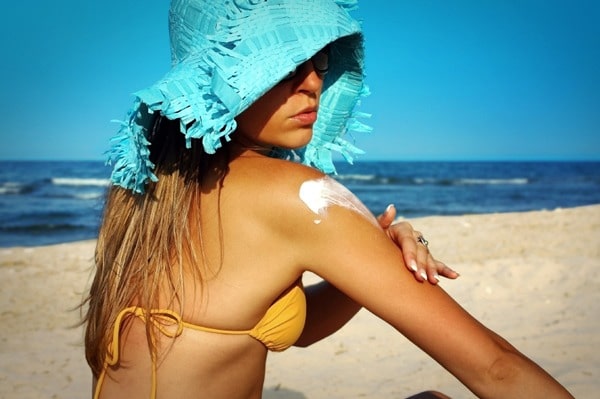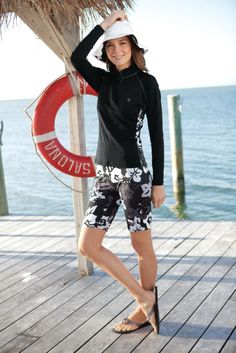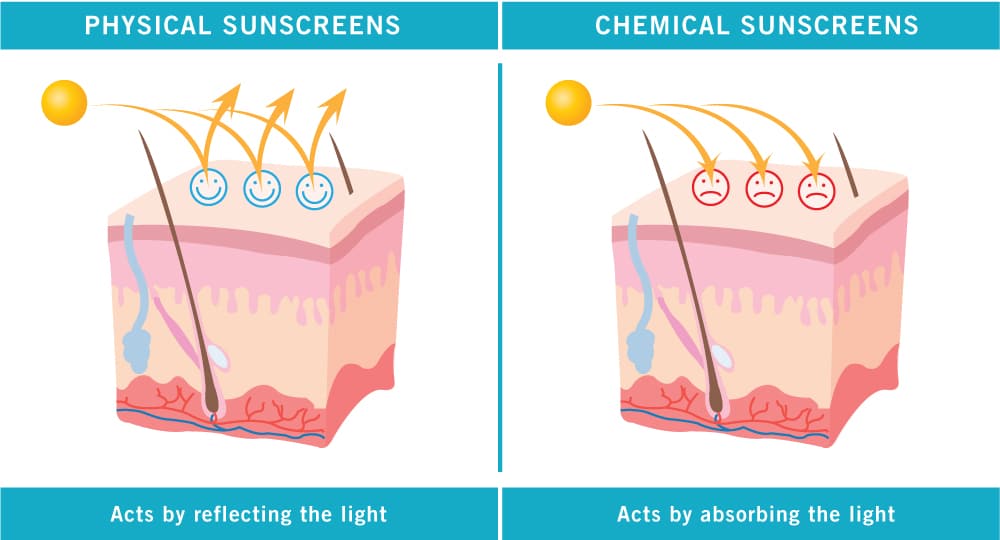Do Chemical Sunscreens Increase the Risk of Cancer?
Up until the 1920’s it was not viewed as a positive thing to have a tan… it wasn’t until Coco Chanel was sunburned in the French Riviera and women who saw it believed it to be “glamorous”, that the suntan became a staple of fashion. Hopefully, most of us have adjusted our aesthetic to include healthy sun protection against deep tans and burns. We’ve mostly all gotten the message about sunscreen SPFs, and learned to slather it on for all outdoor activities year-round, and even on cloudy days.

Make a sustainable decision on sunscreen
There is however, still confusion and concern over the idea that sunscreen could be a major contributor to skin cancers. So, does sunscreen cause skin cancer? Chemical sunscreens contain ingredients like avobenzone, methoxycinnamate, padimate-o, and oxybenzone. These chemicals have been found to generate “free radicals”. Furthermore, sunscreen chemicals have been found to pass through the skin and mimic the effects of estrogen, which may disrupt the delicate balance of the body´s natural hormones, another disturbance of the body’s internal chemistry that could also lead to cell mutation.

good cover is the best protection
While skin cancers have always existed there has been a notable increase in the risk of developing melanoma – in 1935, the risk was 1 in 500; today it is closer to 1 in 55, even with the increased use of sunscreen. There are a number of factors that have conspired to make this number so much higher than it used to be. One is that people simply live longer and the sun damage that leads to skin cancer accumulates over long periods of time. Another factor is a thinning ozone layer that allows more ultra-violet radiation to penetrate the earth’s atmosphere. While the rates of cancer have generally increased over time, the diagnostic techniques used to spot skin cancers help it to be detected earlier when it is easier to curb. So could avid sunscreen use and the chemicals in them also be a culprit?
While keeping yourself protected from the sun’s harmful rays it’s also important not to go too extreme in the other direction. No one should hide in the dark all day everyday and moderate levels of exposure to the sun, and the Vitamin D that comes with it, can even help decrease the risk of melanoma. It’s through sunlight exposure that your body is able to produce vitamin D, which then converts it to hormones that the body’s organs use to repair damaged and cancerous cells. Optimized Vitamin D levels are key to preventing melanoma and other cancers, and chronic overuse of sunscreens deprives the body of this very import nutrient.. At the same time, overexposure is never good and regardless of your skin type or ethnicity, all the evidence points to the need to protect against ultraviolet rays. Most dermatologists recommend using sunscreens that protect against both forms of ultraviolet radiation A and B (UVA and UVB). The body can only produce a small amount of vitamin D via UVR. Once the limit has been reached (for most people this is less than 30 minutes), additional exposure results in a breakdown of vitamin D which is what causes burns and other skin issues.
What is the Best Type of Sunscreen?
The best type of sunscreen is a hat and a long sleeve shirt. But if you’re going to show skin it really depends on your needs. There are 2 basic categories that sunscreens fall into – mineral and non-mineral and while both have downsides the natural, mineral based brands are your best bet. The mineral based brands actually reflect harmful rays, while chemical sunscreens absorb them. Most non-mineral products currently on the market are filled with chemicals that have the potential to cause the health problems described above. As a general rule you would want to look at the ingredients and avoid anything with the names of chemicals you don’t recognize. Most chemical sunscreens include a combination of two to six of the following ingredients: oxybenzone, avobenzone, octisalate, octocrylene, homosalate, retinol palmitate and octinoxate. The Environmental Working Group’s Cosmetic Safety Database, (http://www.ewg.org/2015sunscreen/) provides a helpful rating of sunscreen ingredients and offers suggestion for brands with less chemical-based formulas, yet that still provide appropriate protection.

Environmental Issues
When you’re putting on sunscreen it’s pretty unlikely that you’re thinking “how will this affect the ocean when it washes off my skin” and while one person may not do a lot of damage, millions of people entering the water each day lathered in chemicals has an effect that increases exponentially and hurts the ecosystems in our oceans. Studies have linked specific chemical UV filters in sunscreens with the transsexualization of male fish and coral reef degradation.
There is plenty of proof that the chemicals such as oxybenzone are increasingly degrading coral reefs in our oceans but it is still important to take care of your skin and protect it from harmful rays, sunburn and cancers. However, divers, boaters, fisherman and others who spend hours daily on or in the water are exposed to intense reflected sunlight. For these people some kind of sunscreen / protection is absolutely mandatory. So what’s the best course of action?
When you purchase sunscreen be aware of what it contains – look at the ingredients. The active ingredients in most mineral sunscreens are zinc and titanium dioxide — these minerals are not generally harmful to coral and other sea life. Some sunscreens can also contain mineral oils, which are derived from petroleum. These chemicals have a low solubility rate in water and are known to be harmful or even fatal to some marine life and birds and should be avoided.
Making the Best Choice For Our Bodies & The Environment
Most experts will agree that the benefits of using sunscreen far outweigh any risks, but it’s also wise to consider all factors when making a decision. Knowing that overexposure to the sun is risky and that many sunscreens can have negative health and environmental consequences, what are your options? There are currently several companies working on sunscreens that are safe for the oceans but until those arrive at our supermarket there are other more natural ways to enjoy the sun safely.
First, eat well. Vegetables have an anti-oxidizing effect and can also help fight against skin cancer. Here are some examples of beneficial foods to help protect your skin this summer:

Berries contain Resveratrol a powerful antioxidant
Red Wine, Blueberries, Red Grapes – Resveratrol: Resveratrol prevents things like the premature aging of cells and the production of “nf kappa b”, a powerful, noxious inflammatory agent.
Salmon, Fish, Fish Oil – Omega-3 Fatty Acids & Astaxanthin: These help hydrate your skin and hair.
Green Tea – Catechins: help fight disease and inflammation.
Pumpkin Seeds, Almonds & Asparagus – Vitamin E: Destroys Free Radicals and promotes healthy skin cell growth.
Carrots & Red Bell Peppers – Beta-Carotene: Beta-Carotene is converted by the body into vitamin A (retinol), which acts as an antioxidant to help protect cells from the damaging effects of harmful free radicals.

covering up is the best sunscreen
Additionally, here are some “sun safety tips” that take all of the factors we discussed into account:
- Get 20+ minutes of sunshine daily in the earlier or latter parts of the day (before 1 pm and after 5 pm, when the sun is not at its strongest)
- Cover up with light clothing and a hat before you go outside
- Wear natural sunscreen if you’re going to stay out for a long period of time
- Eat a diet high in antioxidants to protect your skin
If you do get sunburned, an effective natural remedy for treating sunburn is to combine a mixture of equal parts aloe, coconut oil and vitamin E and spread it immediately on the affected area. If you do not have all of these ingredients use what is available to you. The mixture is effective because aloe and coconut oil both contain moisturizing agents and antioxidants, while vitamin E destroys free radicals.
Another tried and true sunburn remedy, is to make a tea bath and soak it for half an hour as soon as you realize you are burned. Drop 4 -5 family-sized Lipton (or black) tea bags into a full bathtub of lukewarm water. The tannins in the tea work to neutralize and soothe the pain of the burn.
Whatever you do, be conscious of your skin and stay safe in the sun this summer!
sources:
http://draxe.com/75-of-sunscreens-are-toxic-what-to-do-instead/
http://www.washingtonpost.com/wp-dyn/content/article/2008/06/26/AR2008062603224.html

Recent Comments